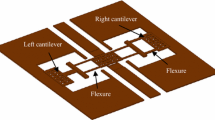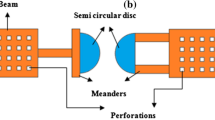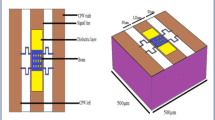Abstract
This paper presents a series combination of metal to metal contact and capacitive RF-MEMS switches for multi-band wireless applications. For performance improvement a novel capacitive shunt switch is used and the response has been compared with a conventional shunt device. The proposed design shows the insertion loss better than 0.35 dB and return loss below 13.96 dB up to 30 GHz as compared to 1.64 dB insertion loss and 6.14 dB of return loss with conventional device. Isolation peaks of 75.33, 71.58 and 72.98 dB has been observed at 8.2, 7.3 and 15.5 GHz when left, right or both cantilevers are electro-statically actuated in the down-state respectively, whereas conventional device has peak only at 7.3 GHz. Further, a reduction of about 60 % in the pull-in voltage of capacitive switch and 17.5 % in device area has also been observed. The proposed design can be used as a building block for multiple throw switches and switch matrices for the future reconfigurable RF front end applications.
Similar content being viewed by others
Avoid common mistakes on your manuscript.
1 Introduction
Telecommunication industries are growing at a rapid pace. New wireless standards are coming-up requiring reconfigurable devices with low insertion loss, high isolation and low power consumption. RF-MEMS is becoming an attractive technology for the above cited purpose. Amongst the different devices, switches have gained much attention. MEMS switches show remarkable advantages over their solid state counterparts [1–5]. These switches are used at various places in telecommunication systems, including signal routing, digitized capacitor banks, phase shifters, reconfigurable antenna, switch matrix and multi-port switches etc. [1, 6]. The capacitive switches are used for designing the multiple throw switches at higher frequencies (f ≥ C band). But these SPNTs occupy the large chip area and have limited bandwidth because of requirement of λg/4 transmission line section [6]. Alternatively, ohmic switch can be combined in series with capacitive one to make reconfigurable SPNTs with minimum chip area [7–10].
However, this approach has high insertion loss because of the combined effect of two switches. This paper presents an improved design for the series-shunt device. The insertion loss and isolation characteristics have been improved through a novel asymmetric structure based capacitive RF-MEMS switch [3]. Float metal concept is utilized for reducing the insertion loss and tuning the isolation peaks in different frequency bands [3, 4]. A shunt switch with conventional approach is also being designed for comparing the performance. Figure 1a, b shows the model of the device with the proposed and conventional approach.
2 Device description and working
The presented configuration consists of a series ohmic switch cascaded with shunt capacitive switch. Ohmic Switch is implemented with bridge type structure. A uniform bridge requires more pull-in voltage so four flexures and a central plate have been chosen to reduce the pull-in voltage. The switch is anchored in between the ground planes of CPW. The actuation electrode is placed under the central plate of bridge structure to reduce the pull-in voltage and to provide uniform distribution of force on the contact area. In OFF state of the switch there is a gap of 2 µm between switch and central conductor of CPW.
In shunt configuration the input and output RF ports are physically connected to each other and therefore normally switch is ON. The switch is based on a 50 Ω CPW line. The conventional switch is implemented with a bridge structure having four flexures and a central plate. Further, SiO2 with dielectric constant of 4 has been placed over the central conductor of CPW. In order to pick the full down-state capacitance a float metal has been deposited over the dielectric layer. This device has been transformed into the proposed switch by removing the middle part of the bridge structure. Thus, the proposed switch has the non-uniform cantilever in either side of the transmission line. The overlap area between the free end of cantilevers and central conductor of CPW form two capacitors in the up-state. In order to realize the multi-band functionality, inductance value has been kept different in either side cantilevers through asymmetric structures.
The ohmic and novel asymmetric structure based shunt capacitive switch are combined to implement a series-shunt configuration. This cascaded device has high isolation and wide bandwidth. The switch provides high isolation when the series switch is in the up-state and the shunt switch is in the down-state. The switch provides low return loss when the series switch is in the down-state and the shunt switch is in the up-state. The fabrication processes for the two switches are compatible (Table 1).
2.1 Ohmic and capacitive switch working
Series MEMS switch is based on the same principle as the simple mechanical moving switch. The beam moves mechanically when actuated to close the switch. Electrostatic actuation is used here because of its compatibility with IC technology. As it is a series ohmic switch the input and output RF ports are physically isolated from each other. The switch is therefore normally OFF. The conventional bridge based capacitive switch operates in two states. With up-state of the bridge, the device is ON whereas down-state corresponds to OFF state. The novel shunt switch has four different states. With all cantilevers in the up position, the signal flows from the input to the output port as shown in Fig. 2a. OFF state can be achieved by pulling down the left, right or both cantilever in the down position through electro-static actuation. Figure 2b shows the isolation state when the right beam connects ground to the float central capacitive area. As the left cantilever is having less inductance than the right, switching it down shift the isolation peak to a higher frequency. This state is shown in Fig. 2c. Finally, when all beams are in down position inductance becomes even less and shifts the isolation peak to a much higher frequency. Thus, proposed device shows three resonant frequencies in the OFF state.
2.2 Series-shunt device working
Figure 1a, b shows the two different configurations for series-shunt devices. The configuration based on series ohmic switch cascaded with a conventional capacitive switch can work in three different states. With ohmic switch in the down-state and capacitive in the up-state corresponds to the ON state. The device shows isolation in the unactuated position. The optimum isolation in the OFF state can be shifted to the C band by actuating the capacitive switch to the down-state. The device with the novel asymmetric structure based capacitive switch has two additional OFF states as compared to the previous configuration. The extra states are due to the cantilever based structure in the either side of the transmission line.
3 RF response of series-shunt device
3.1 ON state response
Figures 3 and 4 show the ON state response of the both devices. The considerable improvement has been achieved in insertion loss and return loss characteristics as compared to the device with conventional approach based capacitive switch. This is due to the reduced capacitance value in the up-state of the novel capacitive switch. From Eq. (1) capacitance in the up-state can be reduced either by decreasing the Aup or increasing the ‘g’, where Cup_con = capacitance in the up-state of the conventional switch. Any increment in ‘g’ will increase the pull-in voltage. Alternatively, capacitance in the up-state could be reduced by decreasing Aup value, but this will change the resonate frequency during OFF state of the device.
In the proposed design, the issue is resolved by reducing the up-state area without changing the resonant frequency by utilizing the float metal concept. Equation (2) shows the overall up-state capacitance value for the proposed switch i.e. Cup_net_Pro. This capacitance is due to the overlap area between the left, right cantilever and the central conductor of CPW. Equation (3) shows that Cup_net_Pro is around 7 times less than the Cup_Con. The insertion loss has also been improved as the transmission line length has been reduced by 225 μm in case of asymmetric design. Further, this reduction leads to about 17.5 % device area as compared to the conventional device. In order to investigate the RF performance of both the devices a 3-D structure was created and simulated in Ansys HFSS™. Insertion loss of 0.01–0.35 and 0.01–1.64 dB have been observed in the case of proposed and conventional devices respectively for the frequency range from d.c to 35 GHz as shown in Fig. 3. Return loss is below 13.96 and 6.14 dB for the novel device and conventional design respectively up to 30 GHz as shown in Fig. 4.
3.2 OFF state response
In addition to reducing the up-state capacitance float metal concept also allows to make asymmetric structures on either side of the transmission line and thus isolation peaks can be tuned to different bands. Figure 5a, b shows the isolation characteristics of both devices. Isolation peaks of 75.33, 71.58 dB have been observed at 8.2, 7.3 GHz when left and right cantilever actuated to the down-state respectively. As resonant frequency is the function of the capacitance and inductance, pulling down the both cantilevers shift the isolation peak in K-band. A peak value of 72.98 dB has been observed at 15.5 GHz, whereas conventional device has peak only at 7.3 GHz.
3.3 Switch bandwidth
The series-shunt device bandwidth can be calculated from the upper operating frequency. The upper frequency (fU) is limited by the maximum insertion loss or by minimum isolation. For bandwidth calculation an acceptable maximum insertion loss of 0.4 dB and minimum isolation of 30 dB has been chosen. It is observed from Fig. 6a, b that upper operating frequency is limited by insertion loss. The device with conventional capacitive switch can operate from d.c to 10.92 GHz. Figure 7a shows the bandwidth of the proposed device when both switches are in their unactuated state. The device has upper cut-off frequency of 12.74 GHz.
In case of ohmic switch is in up-state and right cantilever is actuated to down-state, device has a bandwidth of 20.92 GHz. With left cantilever to the down-state, bandwidth has increased till 22.74 GHz. Finally, with both cantilevers to the down-state, device can operate till 30 GHz as shown in Fig. 7d. Thus, the proposed device has around three times more bandwidth as compared to the conventional design.
In electro-mechanical response pull-in voltage is the parameter of concern. Pull-in voltage is dependent on the length, width, thickness, Young‘s modulus of the hanging structure, initial gap between the actuation electrode and movable structures and actuation area. Pull-in voltages are determined by doing FEM simulation in Coventorware(R). Ohmic switch has Pull-in voltage of 16 V whereas it is 10.5 V for conventional bridge based capacitive switch as shown in Fig. 8. In case of asymmetric capacitive switch, right and left cantilever has pull-in voltage of 3.25 and 4 V respectively.
4 Conclusion
The series-shunt switch using a new type of capacitive shunt RF-MEMS switch has been designed and investigated. Significant improvement in insertion loss has been observed as compared to conventional approach. Further, resonant peaks during OFF state response are tuned in different frequencies band for achieving reconfigurability. Further, a reduction of about 60 % in the pull-in voltage of capacitive switch and 17.5 % in device area have also been observed The device can be used as a building block for multiple throw switches operating in the frequency range from d.c to 30 GHz.
References
Brown, E.R.: RF-MEMS switches for reconfigurable integrated circuits. J. IEEE Trans. Microw. Theory Tech. 46(11), 1868–1880 (1998)
Rangra, K., Margesin, B., Lorenzelli, L., Giacomozzi, F., Collinni, C., Zen, M., Gsonicini, S., Tin, L.D., Gaddi, R.: Symmetric toggle switch—a new type of rf MEMS switch for telecommunication applications: design and fabrication. J. Sens. Actuators A 123–124, 505–514 (2005)
Angira, M., Rangra, K.: Performance improvement of RF-MEMS capacitive switch via asymmetric structure design. J. Microsyst. Technol. (2014). doi:10.1007/s00542-014-2222-8
Angira, M., Sundaram, G.M., Rangra, K.: A novel approach for low insertion loss, multi-band, capacitive shunt RF-MEMS switch. J. Wirel. Pers. Commun. (2015). doi:10.1007/s11277-015-2521-0
Angira, M., Rangra, K.: A low insertion loss, multi-band, fixed central capacitor based RF-MEMS switch. J. Microsyst. Technol. (2014). doi:10.1007/s00542-014-2378-2
Pacheco, S.P., Peroulis, D., Katehi, L.P. B.: MEMS single-pole double-throw (SPDT) X and K-band switching circuits. In: Proceedings of IEEE Microwave Symposium Digest, Phoenix, AZ, USA, pp. 321–324 (2001)
DiNardo, S., Farinelli, P., Giacomozzi, F., Mannocchi, G., Marcelli, R., Margesin, B., Mulloni, P.M., Russer, V., Sorrentino, R., Vitulli, F., Vietzorreck, L.: Broadband RF-MEMS based SPDT. In: Proceedings of European Microwave Conference, Manchester, pp. 1727–1730 (2006)
Muldavin, J.B., Rebeiz, G.M.: Novel series and shunt MEMS switch geometries for X-band applications. In: Proceedings of European Microwave Conference, Paris, pp. 1–4 (2000)
Farinelli, P., Giacomozzi, F., Mannocchi, G., Marcelli, R., Margesin, B., Mezzanotte, P., Nardo, S.D., Russer, P., Sorrentino, R., Vitulli, F., Vietzorreck, L.: RF-MEMS SPDT switch on silicon substrate for space applications. In: Proceedings of Topical Meeting on Silicon Monolithic Integrated Circuits in RF Systems, Atlanta, USA, pp. 151–154 (2004)
Lucibello, A., Marcelli, R., Proietti, E., Bartolucci, G., Mulloni, V., Margesin, B.: Reliability of RF MEMS capacitive and ohmic switches for space redundancy configurations. J. Microsyst. Technol. (2014). doi:10.1007/s00542-014-2124-9
Author information
Authors and Affiliations
Corresponding author
Rights and permissions
About this article
Cite this article
Angira, M., Sundaram, G.M. & Rangra, K. Performance improvement of a reconfigurable series-shunt switch via asymmetric structure based RF-MEMS capacitive switch. Int J Adv Eng Sci Appl Math 7, 198–203 (2015). https://doi.org/10.1007/s12572-015-0146-x
Published:
Issue Date:
DOI: https://doi.org/10.1007/s12572-015-0146-x












